Perpignan (and rugby)
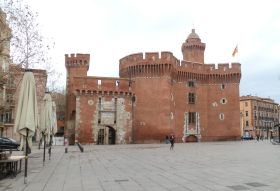 Perpignan is the closest French city to the Costa Brava and is reachable in about 80 minutes from where we live. In distance terms it's closer than Barcelona which means that when we want something special, travelling to France is another possibility.
Perpignan is the closest French city to the Costa Brava and is reachable in about 80 minutes from where we live. In distance terms it's closer than Barcelona which means that when we want something special, travelling to France is another possibility.
Perpignan itself was originally an important Catalan town, part of the old Catalan county of Roussillon and only became French in 1659. As a result modern Perpignan and the local area style themselves as being part of Catalunya Nord with signs in both French and Catalan (not Spanish) and there is a strong affinity for Catalonia. However, it also has a strong French feel and there is definite change when you cross the border.
One of the visible changes is that you see rugby posts in the sports fields. Like many places in the south of France, people around Perpignan are fanatical about rugby and Perpignan itself has not one professional rugby team, but two. For rugby union there is the USAP (Union Sportive des Arlequins de Perpignan) who play in the French premier rugby league (Top 14), and for rugby league the Catalan Dragons who play as the only non-English club in the Super League for rugby league.
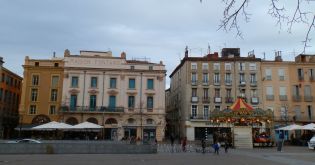 Coming from the West Country, I was brought up on rugby rather than football and as it happens Gloucester, which used to be our local rugby club was playing Perpignan in the pan-European Heineken Cup competition so this was a chance to get to see my old home team once more.
Coming from the West Country, I was brought up on rugby rather than football and as it happens Gloucester, which used to be our local rugby club was playing Perpignan in the pan-European Heineken Cup competition so this was a chance to get to see my old home team once more.
Unfortunately on the Spanish side of the border, rugby is still very much a minor sport in Catalonia. There is only one club for the Costa Brava - Senglars in Torroella de Montgri, and there is one in Girona. Barcelona has more across the city, and is trying to increase participation with help from USAP, and about four years ago, USAP came down to Barcelona to play Toulon in the Heineken cup at the Olimpic Stadium with 55,000 spectators, much to the city's surprse.
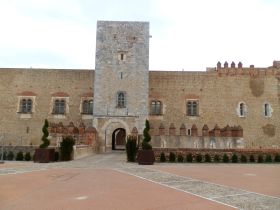 Before we watched the rugby, we took a brief walk around the main town. It's actually a place we visit reasonably often. The shopping is different from the Spanish side of hte border - many French products don't make it across the frontier and there is generally a better selection of produce, and a different selection of goods and a different style and range and though prices tend to be a little higher in France, there are still some bargains for cross-border consumption.
Before we watched the rugby, we took a brief walk around the main town. It's actually a place we visit reasonably often. The shopping is different from the Spanish side of hte border - many French products don't make it across the frontier and there is generally a better selection of produce, and a different selection of goods and a different style and range and though prices tend to be a little higher in France, there are still some bargains for cross-border consumption.
We parked near the rugby stadium (Aime Giral) which is to the south of the city and about a 7-8 minute stroll to the city centre. As we were walking up into town, lots of cherry-and-white Gloucester supporters were walking towards the stadium the other way. One tradition with many rugby teams, and USAP is no different, is that there is hospitality for visiting fans through the morning and the stadium itself has a number of bars and lounges for eating around the bottom for members and visitors.
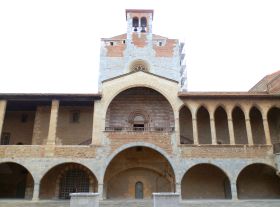 Our route took us over the river (the Tech) and then into town in front of the Castillet. This is a large red-brick castle/town gate that marks the entrance to the old city area. This is just across the canalised river Basse. From this point a network of old streets and buildings form the heart of the old town, most of which have been converted to plush shops or restaurants. There is plenty to explore, but we walk through the older section to emerge by the Place de la Republic, a large square with a merry-go-round in it and bars and restaurants all around.
Our route took us over the river (the Tech) and then into town in front of the Castillet. This is a large red-brick castle/town gate that marks the entrance to the old city area. This is just across the canalised river Basse. From this point a network of old streets and buildings form the heart of the old town, most of which have been converted to plush shops or restaurants. There is plenty to explore, but we walk through the older section to emerge by the Place de la Republic, a large square with a merry-go-round in it and bars and restaurants all around.
We then head upwards in terms of height in among the smaller streets of houses. Unfortunately the houses and area is a little run down and there is dog-mess all over the pavements (a problem we found all over Perpignan). Going up we reach the outer walls of the great Vauban fortification that surrounds the Palace of the Kings of Majorca - another ciutadella or fort construction built as a response to the annexation of this part of Catalonia in the 17th century.
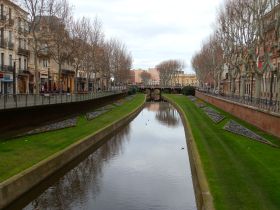 The walls, like the other forts in Catalona - Salses, Figueres, Roses, Girona, are massive and we skirt around the outside to find the entrance. The scale of the building is surprising - particularly as it took us several visits to realise it was there. But it doesn't stop. A gate passes through the outer walls and a broad flight of shallow steps runs up inside the wall emerging at an open level giving great views over the city and out to the mountains of Corbiere towards Narbonne, and to Canigou and the Pyrenees.
The walls, like the other forts in Catalona - Salses, Figueres, Roses, Girona, are massive and we skirt around the outside to find the entrance. The scale of the building is surprising - particularly as it took us several visits to realise it was there. But it doesn't stop. A gate passes through the outer walls and a broad flight of shallow steps runs up inside the wall emerging at an open level giving great views over the city and out to the mountains of Corbiere towards Narbonne, and to Canigou and the Pyrenees.
But we're not finished. Another shallow set of steps reaches the top and we reach the topmost building - the Palace of the Kings of Majorca - a much older Catalan castle/palace built when Jaume II King of Majorca (and son of the King of Aragon) made Perpignan the capital of the Kingdom of Majorca in 1276. We go inside just to take the picture, but we're on a schedule for the rugby so we don't have time to visit more thoroughly this time.
We walk back down into the old city and out past the Palais de Justice and along the canalised river back towards the stadium. Being a Sunday a few food places are open but all the main shopping is closed. On a Saturday this is a thriving shopping area with all the standard French high-street stores like Fnac.
And so to the rugby. What might be surprising is that USAP's club song is sung in Catalan, a Lluis Llach standard that our children learnt in school here. The game is good natured with calls of USAP matched by the sound of visiting supporters chanting Glo..st..er in the long west country accent. Gloucester won 18-36.
See also: Andorra La Vella - Figueres and Castell de Sant Ferran - Girona - Festa Major of Sant Narcis - Puigcerda and Bourg-Madame - Cadaques and Port Lligat
Also in France close to the Costa Brava
White water rafting in Quillan (France) - Collioure (France) - Villefranche-de-Conflent and Mont-Louis (France) - Elne (France) - Ceret (France) - Andorra La Vella

 Walks and other things
Walks and other things